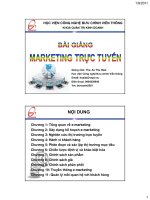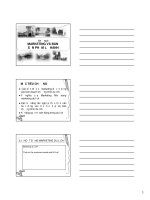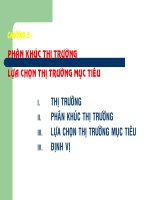Bài giảng MARKETING MANAGEMENT LECTURE NOTES: chap 5 analyzing consumer markets
Bạn đang xem bản rút gọn của tài liệu. Xem và tải ngay bản đầy đủ của tài liệu tại đây (683.87 KB, 16 trang )
3/8/2018
1
5
Analyzing
Consumer Markets
Sources:
Text book: Marketing Management. Kotler &
Keller. 14th edition (Global version).
Internet
Kotler 14th edition ppt.
Kotler 13th edition ppt.
Copyright © 2011 Pearson Education, Inc. Publishing as Prentice Hall
6-2
Roadmap:
What influences consumer behavior?
Key Psychological processes
Cultural, Social, Personal
Motivation (Freud, Maslow, Herzberg), Perception, learning,
Emotions, Memory
The buying decision process
The five-stage model
Behavioral decision theory and behavioral
economics
Copyright © 2011 Pearson Education, Inc. Publishing as Prentice Hall
5-3
1
3/8/2018
Chapter Questions
How do consumer characteristics influence
buying behavior?
What major psychological processes influence
consumer responses to the marketing
program?
How do consumers make purchasing
decisions?
In what ways do consumers stray from a
deliberate rational decision process?
Copyright © 2011 Pearson Education, Inc. Publishing as Prentice Hall
6-4
Consumer Behavior : The study of how
individuals, groups, and organizations select, buy, use,
and dispose of goods, services, ideas, or experiences
to satisfy their needs and wants.
Copyright © 2011 Pearson Education, Inc. Publishing as Prentice Hall
6-5
What Influences
Consumer Behavior?
Cultural Factors:
broadest and deepest
Social Factors
Personal Factors
Copyright © 2011 Pearson Education, Inc. Publishing as Prentice Hall
6-6
2
3/8/2018
What is Culture?
Culture is the fundamental determinant of a
person’s wants and behaviors acquired
through socialization processes with family
and other key institutions.
Cultures differ across the world (Arabian,
American, European, Asian,…)
Copyright © 2011 Pearson Education, Inc. Publishing as Prentice Hall
6-7
Subcultures
Each culture consists of smaller subcultures that provide
more specific identification and socialization for their
members.
Nationalities (Arabian culture: Jordanian,
Libyan, Iraqi,…subcultures)
Religions (Muslims, Christians, Jews,…)
Racial groups (Arabs, Kurds, Turkish origin,…)
Geographic regions (North, South, Sea,
Desert,….)
Copyright © 2011 Pearson Education, Inc. Publishing as Prentice Hall
6-8
Fast Facts About
American Culture
The average American:
chews 300 sticks of gum a year
goes to the movies 9 times a year
takes 4 trips per year
attends a sporting event 7 times each
year
Copyright © 2011 Pearson Education, Inc. Publishing as Prentice Hall
6-9
3
3/8/2018
Social Classes: appears as a result of social
stratification, homogeneous divisions, hierarchically ordered,
share same values, interests, and behaviors.
Upper uppers
Lower uppers
Upper middles
Middle
Working
Upper lowers
Lower lowers
Copyright © 2011 Pearson Education, Inc. Publishing as Prentice Hall
6-10
Social Factors
Reference groups
Family
Social roles
Statuses
Copyright © 2011 Pearson Education, Inc. Publishing as Prentice Hall
6-11
Reference Groups: All the groups that
have a direct (face to face) or indirect
influence on their attitudes of behavior.
Membership groups: Direct influence.
A- Primary groups :continuous and informal
communication (family, friends, coworkers,…)
B- Secondary groups: More formal and less
frequent communication (religious, professional,
trade-union groups).
Aspirational groups: hope to join.
Dissociative groups: individual rejection.
Copyright © 2011 Pearson Education, Inc. Publishing as Prentice Hall
6-12
4
3/8/2018
Family Distinctions affecting Buying
Decisions:
Family is the most important consumer buying
organization in the society.
Family of Orientation: parents and siblings (Insurance
example)
Family of procreation: spouse and children. (traditional
purchasing roles are changing and marketers tend now to
focus more on different targets
separately or collectively).
Copyright © 2011 Pearson Education, Inc. Publishing as Prentice Hall
6-13
Roles and Status
What degree of status is
associated with various
occupational roles?
Copyright © 2009 Pearson Education, Inc. Publishing as Prentice Hall
6-14
Personal Factors
Age
Life cycle stage
Occupation
Wealth
Copyright © 2011 Pearson Education, Inc. Publishing as Prentice Hall
Personality
Values
Lifestyle
Self-concept
6-15
5
3/8/2018
Age and Stage of Lifecycle:
Newly
weds spend 70 Billion $ in the 1st year after marriage. Also
they buy more in the 1st 6 months than what a family does in 5
years. (P&G, Clorox, Palmolive-Colgate : newly wed kits)
Copyright © 2011 Pearson Education, Inc. Publishing as Prentice Hall
6-16
Occupation and Economic
Circumstances : Snap fitness showed a
success story during recession times (Fast,
convenient, affordable).
Copyright © 2011 Pearson Education, Inc. Publishing as Prentice Hall
6-17
Personality and Self concept: Joie de
vivre chain of hotels, restaurants and resorts has an
online personality matchmaker to help the guest select
the most fitting hotel.
Copyright © 2011 Pearson Education, Inc. Publishing as Prentice Hall
6-18
6
3/8/2018
Brand Personality:
consumers tend to
choose brands whose personalities match their own.
Sincerity: Campbell
Excitement: MTV
Competence: CNN
Sophistication: Rolex
Ruggedness: Levi’s
Copyright © 2011 Pearson Education, Inc. Publishing as Prentice Hall
6-19
Lifestyle and values :
Time-Famine: Multitasking
Money-constrained: Low
Cost products (Walmart).
Core values
Copyright © 2009 Pearson Education, Inc. Publishing as Prentice Hall
6-20
Table 6.2 LOHAS Market Segments
(Lifestyles of
Health and Sustainability)
41 Million people, 209 Billion $ market.The
market for LOHAS products encompasses
organic foods, energy-efficient appliances,
alternative medicine, yoga tapes.
Sustainable Economy
Healthy Lifestyles
Ecological Lifestyles
Alternative Health Care
Personal Development
Copyright © 2011 Pearson Education, Inc. Publishing as Prentice Hall
6-21
7
3/8/2018
Consumer behavior
The starting point for understanding consumer
behavior is the stimulus-response model shown in
next slide.Marketing and environmental stimuli enter
the consumer’s consciousness, and a set of
psychological processes combine with certain
consumer characteristics to result in decision
processes and purchase decisions. The marketer’s
task is to understand what happens in the consumer’s
consciousness between the arrival of the outside
marketing stimuli and the ultimate purchase decisions.
Four key psychological processes—motivation,
perception, learning, and memory—fundamentally
influence consumer responses.
Copyright © 2011 Pearson Education, Inc. Publishing as Prentice Hall
6-22
Figure 6.1 Model of
Consumer Behavior
Copyright © 2011 Pearson Education, Inc. Publishing as Prentice Hall
6-23
Motivation
Freud’s
Theory
Maslow’s
Hierarchy
of Needs
Herzberg’s
Two-Factor
Theory
Behavior
is guided by
subconscious
motivations
Behavior
is driven by
lowest,
unmet need
Behavior is
guided by
motivating
and hygiene
factors
Copyright © 2011 Pearson Education, Inc. Publishing as Prentice Hall
6-24
8
3/8/2018
Three of the best-known theories of human motivation—those
of Sigmund Freud, Abraham Maslow, and Frederick Herzberg—
carry quite different implications for consumer analysis and
marketing strategy. Sigmund Freud assumed the psychological
forces shaping people’s behavior are largely unconscious, and
that a person cannot fully understand his or her own
motivations. Someone who examines specific brands will react
not only to their stated capabilities, but also to other, less
conscious cues such as shape, size, weight, material, color,
and brand name. Abraham Maslow sought to explain why
people are driven by particular needs at particular times. His
answer is that human needs are arranged in a hierarchy from
most to least pressing—physiological needs, safety needs,
social needs, esteem needs, and self-actualization. We discuss
Maslow’s theory on the next slide. Frederick Herzberg
developed a two-factor theory that distinguishes dissatisfiers
(factors that cause dissatisfaction) from satisfiers (factors that
cause satisfaction). The absence of dissatisfiers is not enough
to motivate a purchase; satisfiers must be present.
Copyright © 2011 Pearson Education, Inc. Publishing as Prentice Hall
6-25
Maslow’s Hierarchy
Need 5: Art world
Need 3&4: Self
image and how
he’s viewed by
others
Need 2: Clean air
for breathing
Need 1: Food,
water, basics.
Copyright © 2011 Pearson Education, Inc. Publishing as Prentice Hall
6-26
Perception : is the process by which we
select, organize, and interpret information inputs to
create a meaningful picture of the world
Selective attention: marketers must work hard
to attract consumers’ notice.
Selective retention: Likelihood to remember
good points about a product we like and forget
good points about competing products.
Selective distortion: the tendency to interpret
information in a way that fits our preconceptions.
Subliminal perception: marketers aim to embed
subliminal, covert messages in ads or packaging.
Copyright © 2011 Pearson Education, Inc. Publishing as Prentice Hall
6-27
9
3/8/2018
Learning: induces changes in our behavior
arising from experience.
Copyright © 2011 Pearson Education, Inc. Publishing as Prentice Hall
6-28
Learning
Learning theorists believe learning is produced
through the interplay of drives, stimuli, cues,
responses, and reinforcement.. A drive is a strong
internal stimulus impelling action. Cues are minor
stimuli that determine when, where, and how a person
responds. Suppose you buy an HP computer. If your
experience is rewarding, your response to computers
and HP will be positively reinforced. Later, when you
want to buy a printer, you may assume that because it
makes good computers, HP also makes good printers.
In other words, you generalize your response to
similar stimuli. A countertendency to generalization is
discrimination. Discrimination means we have learned
to recognize differences in sets of similar stimuli and
can adjust our responses accordingly.
Copyright © 2011 Pearson Education, Inc. Publishing as Prentice Hall
6-29
Emotions
Copyright © 2011 Pearson Education, Inc. Publishing as Prentice Hall
6-30
10
3/8/2018
Memory: Short and Long term.
Brand associations consist of all brand-related thoughts, feelings,
perceptions, images, experiences, beliefs, attitudes, and so on that become
linked to the brand node.(Associative model).
Copyright © 2011 Pearson Education, Inc. Publishing as Prentice Hall
6-31
Figure 6.3 State Farm Mental Map
Copyright © 2011 Pearson Education, Inc. Publishing as Prentice Hall
6-32
Figure 6.4 Consumer Buying Process
Problem Recognition
Information Search
Evaluation of alternatives
Purchase Decision
Postpurchase Behavior
Copyright © 2011 Pearson Education, Inc. Publishing as Prentice Hall
6-33
11
3/8/2018
Sources of Information
Personal
Family,
friends
Public
Mass Media
Commercial
Advertising
Salesman
Experiential
Personal
Copyright © 2011 Pearson Education, Inc. Publishing as Prentice Hall
6-34
Figure 6.5 Successive Sets in
Decision Making
Copyright © 2011 Pearson Education, Inc. Publishing as Prentice Hall
6-35
Table 6.4 A Consumer’s Brand
Beliefs about Laptop Computers
Expectancy-value model of attitude formation in
decision making.
To find the consumer’s perceived value for each laptop according to the
expectancy-value model, we multiply his/her weights by his/her beliefs
about each computer’s attributes.
Copyright © 2011 Pearson Education, Inc. Publishing as Prentice Hall
6-36
12
3/8/2018
Figure 6.6 Steps Between
Alternative Evaluation
and Purchase
Attitudes depend on:
intensity of negative
attitude, and the
motivation to comply
with other’s wish.
Copyright © 2011 Pearson Education, Inc. Publishing as Prentice Hall
6-37
Non-Compensatory Models of Choice
Conjunctive: the consumer sets a minimum acceptable cutoff
level for each attribute and chooses the first alternative that meets the
minimum standard for all attributes.
Lexicographic:
Elimination-by-aspects:
the consumer chooses the best brand on the
basis of its perceived most important attribute.
the consumer compares brands on
an attribute selected probabilistically—where the probability of choosing
an attribute is positively related to its importance—and eliminates brands
that do not meet minimum acceptable cutoffs.
Copyright © 2011 Pearson Education, Inc. Publishing as Prentice Hall
6-38
Perceived Risk
Functional:
Not up to expectations
Physical:
Threatens health
Financial:
Not worth the price
Social:
Embarrassment
Psychological: affects the mental well-being of the user
Time: The failure of the product results in an opportunity cost of
finding another satisfactory product.
Copyright © 2011 Pearson Education, Inc. Publishing as Prentice Hall
6-39
13
3/8/2018
Figure 6.7 How Customers
Use or Dispose of Products
A key driver of sales frequency is product consumption rate
Copyright © 2011 Pearson Education, Inc. Publishing as Prentice Hall
6-40
Low-Involvement Decision Making
Savers
takes
clothes
consumers
no longer
want and
sell them to
other
consumers
who do
want them
at the right
price.
Copyright © 2011 Pearson Education, Inc. Publishing as Prentice Hall
6-41
The elaboration likelihood model, an influential model of
attitude formation and change, describes how consumers
make evaluations in both low- and high-involvement
circumstances. There are two means of persuasion in their
model: the central route, in which attitude formation or
change stimulates much thought and is based on the
consumer’s diligent, rational consideration of the most
important product information; and the peripheral route, in
which attitude formation or change provokes much less
thought and results from the consumer’s association of a
brand with either positive or negative peripheral cues.
Peripheral cues for consumers include a celebrity
endorsement, a credible source, or any object that
generates positive feelings. Consumers follow the central
route only if they possess sufficient motivation, ability, and
opportunity. We buy many products under conditions of low
involvement and without significant brand differences.
Copyright © 2011 Pearson Education, Inc. Publishing as Prentice Hall
6-42
14
3/8/2018
Decision Heuristics
Availability: Consumers base their predictions on the
quickness and ease with which a particular example of
an outcome comes to mind. If an example comes to
mind too easily, consumers might overestimate the
likelihood of its happening.
Representativeness: Consumers base their
predictions on how representative or similar the
outcome is to other examples.
Anchoring and adjustment: Consumers arrive at
an initial judgment and then adjust it based on
additional information.
Copyright © 2011 Pearson Education, Inc. Publishing as Prentice Hall
6-43
Framing: the manner in which choices are
presented to and seen by a decision maker.
Mental accounting used by marketers can help predict whether
consumers will or will not go to concert after having lost a ticket or
money.
Copyright © 2011 Pearson Education, Inc. Publishing as Prentice Hall
6-44
Mental Accounting
Consumers tend to…
Segregate gains: When a seller has a product with
more than one positive dimension, it’s desirable to have the
consumer evaluate each dimension separately. Listing
multiple benefits of a large industrial product, for example,
can make the sum of the parts seem greater than the whole.
Integrate losses:
Marketers have a distinct
advantage in selling something if its cost can be added to
another large purchase. House buyers are more inclined to
view additional expenditures favorably given the high price
of buying a house.
Integrate smaller losses with larger gains
Segregate small gains from large losses
Copyright © 2011 Pearson Education, Inc. Publishing as Prentice Hall
6-45
15
3/8/2018
Thank You !
Copyright © 2011 Pearson Education, Inc. Publishing as Prentice Hall
6-46
16









